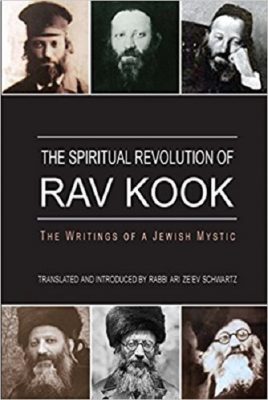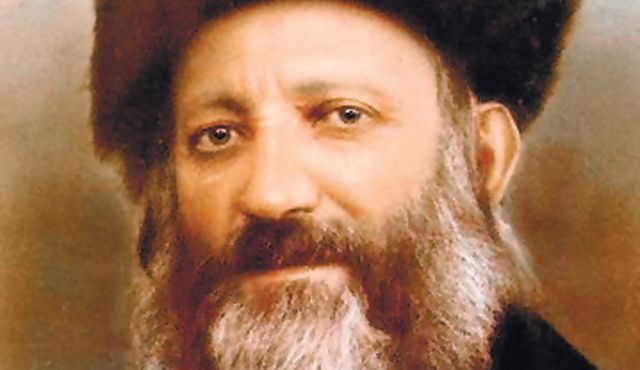A new English translation of the writing of Rabbi Abraham Isaac Kook from Gefen Publishing is available titled “The Spiritual Revolution of Rav Kook,” by Ari Schwartz. Rabbi Ari Schwartz has compiled a selection of what he feels are the most important of Rabbi Kook’s teachings.
Rabbi Abraham Isaac Kook was the first official chief rabbi in Israel’s history. He was appointed by to that position by the British Mandatory authorities before the country’s independence. Rabbi Kook died in 1935, more than a decade before the birth of the State of Israel, but he has been the spiritual and halachic authority identified with the Zionist Orthodox community, known as the “National Religious” in Israel, for almost a century.
Rav Kook is best known for his decision to work with the secular Zionists who were settling the Land of Israel at the start of the 20th Century. Unlike most of the Orthodox who rejected the Zionists, in part because they were secular, and the Reform who rejected them because they no longer believed in Jews as a nation or a people, Rav Kook saw the Zionists as a tool of God’s for the rebuilding of the Land of Israel. He believed that they were engaged in a holy enterprise even if they themselves did not see it that way. And he did not fear interaction with those who were then known as “Maskilim,” modern Jews who had integrated into modern societies and were no longer observers of the commandments.
Many forget that most of the Jewish world rejected Zionism until long after World War I. Rav Kook’s work led to the establishment of the religious Zionist movement. In effect, he was the Herzl of religious Zionism. In 1924 Rav Kook founded his own yeshiva named “Merkaz Harav,” which means center for the many. Many, because he wished it to be an open place for all. To this day the Merkaz Harav Kook yeshiva is the center of religious Zionism.
However, Zionism was not the corps of Rav Abraham Issac Kook’s life’s work. He was also a prolific author, writing many volumes on Jewish law, as well as books on philosophy/spirituality.


And he is also one of the most misunderstood Rabbis of Jewish History. He may have been a Zionist, but his religious practice was more in line with the Haredim (ultra-orthodox) than with the Modern Orthodox community. That being said, long before the Lubavitch were known for conducting worldwide outreach to secular Jews in order to teach them Tora, Rav Kook was the first serious Tora scholar to engage with the secular Jewish community.
(For a full biography of Rav Kook read Yehuda Mirsky’s “Rav Kook: Mystic in a Time of Revolution” from Yale University Press.)
There are already a number of English translations available of the works of Rav Kook. So what makes this new translation different from all of the others? (Happy Pesach) Well as Rabbi Schwartz explains, previous English translations were written in a “higher” level of English, which is much too “lofty” for the average person to appreciate. If you read between the lines then you will understand that he means that academics who are out of touch with everyday people translated his works in an academic manner so that it comes out sounding denser than Shakespeare.
This is certainly true concerning the traditional translations of the writing of the Rambam, Maimonides, especially with his “Guide for the Perplexed.” Have you ever tried to read the Shlomo Pines translation? Doing so feels like sitting through an opera.
And of course Art Scroll has made no effort to offer English translations of the works of Rabbi Kook. I say of course because he was decidedly Zionist, is too associated today with a more liberal version of Orthodoxy and his books were not specifically about Tora or Jewish Law.
Even the original Hebrew versions of Rav Kook’s teachings are challenging for the average Israeli reader because they were written in a grand sort of Hebrew intended to be poetic. Remember that Rav kook passed away in 1935 when Modern Hebrew was still in its infancy. He had not yet learned all of the new verbs and nouns which had never been used before like the words for ice cream and machine. So he wrote as the rabbis before him had written for over a thousand years.
People today may have heard of Rav Kook, they may even know all about him, but few if any have ever had the opportunity to study his writings.
Rabbi Schwartz explains that his book, “is an effort to introduce you to Rav Kook on a personal level, to inspire and challenge you with his wisdom.” He selected passages from the works of Rav Kook which he felt were the most important to convey to the public. These passages cover topics ranging from Torah, God, the individual, teshuva (repentance), prayer, creativity, Zionism, science, and even vegetarianism.
The cofounder and dean of the Society of Independent Spirituality, a learning center in Jerusalem that combines Jewish spirituality and Zionism, Rabbi Schwartz also he teaches at several yeshivot and midrashot in Jerusalem. In the introduction he laments the fact that while most people had heard of Rav Kook, few actually study his works. This is because the secular Jews have no interest in religious writings, the Haredim see him as a Zionist and not a great Rabbi, and the more liberal Orthodox and non-orthodox Jews see Rabbi Kook as too closely connected with Israel’s radical settler movement.
But this translation is not for the uninitiated. First one should learn more about Rabbi Avraham Issac Hacohen Kook. And you should also have a basic understanding of Tora, Jewish law and the Bible.
- On Turning 50 and Other Observations - 8/7/2020
- Pesach Movies To Watch While You Social Distance - 4/12/2020
- You vote for Likud – Not BIBI - 9/16/2019





